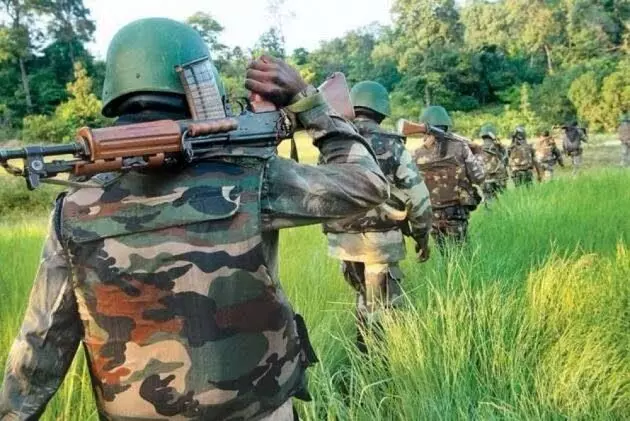Anti-Naxal ops: CRPF moves in over 4,000 troops in Chhattisgarh for decisive action
It was felt that the Naxal violence situation in these two states had improved and incidents were negligible
By Newsmeter Network
New Delhi: The CRPF is moving in four battalions comprising more than 4,000 personnel in the worst Naxal-violence affected areas of Bastar in Chhattisgarh as part of a strategy to launch a "decisive battle" to match the Union government's latest resolve of ending the Maoist problem by March 2026.
Union Home Minister Amit Shah, while declaring this deadline in the Chhattisgarh capital of Raipur last month, emphasised that a "strong and ruthless" plan of action was required to rid the country of Left Wing Extremism (LWE) -- once termed the country's biggest internal security threat.
Official sources said the Central Reserve Police Force (CRPF) -- the lead internal security and anti-Naxal operations force in the country -- withdrew three battalions from Jharkhand and one from Bihar for deployment in the Bastar region, about 450-500 kilometres south of Raipur.
It was felt that the Naxal violence situation in these two states had improved and incidents were negligible. Hence, these battalions can be better utilised in Chhattisgarh, where the anti-Naxal operations are now concentrated, they said.
The CRPF's 159, 218, 214 and 22 battalions are being deployed to add manpower to the existing force in the LWE theatre of Chhattisgarh, the sources said.
Each CRPF battalion has an operational strength of about a 1,000 personnel.
These units are being deployed in the far-flung districts of Dantewada and Sukma and along the remote locations of the state's tri-junction border with Odisha, Andhra Pradesh and Telangana, they said.
A senior officer of the force in Delhi said these battalions would further join hands with the CRPF's CoBRA units to set up more forward operating bases (FOBs) in the districts' remote areas so that development work could be initiated after securing the area.
The force has created about 40 FOBs in Chhattisgarh over the last three years. Setting up such bases comes with its own set of challenges such as ambushes and improvised explosive device attacks by Maoists against the troops, he said.
"These new moving units are being provided logistical support by way of armoured vehicles, UAVs (unmanned aerial vehicles), dog squads, communication sets and ration supplies. The idea is to set foot in all 'no go' and unchartered territories of Bastar so that the LWE menace can be ended, as per the March 2026 deadline decided by the government," he said.
A second officer, however, said these units and other CRPF battalions supporting them would continuously need technology, helicopter and resource support as south Bastar was the most challenging zone for anti-Naxal operations.
"Security forces, including the CRPF, have suffered the maximum casualties in the Bastar area. The decisive operations undertaken now will ensure that the Naxal problem is uprooted from here forever," the officer said.
Logistical support such as construction of roads and helipads, apart from technology and communication facilities, will be continuously required so that the new units can hold the area without taking any casualties. The higher command and the state government have to be responsive to their requirements if the Centre's deadline is to be met, a former CRPF commander said.
Top CRPF brass, during a recent meeting, stressed to its field commanders that the "last nail in the coffin of LWE should be hammered by the CRPF", being the lead force with the highest number of troops.
The country's largest force, with about 3.25 lakh personnel, has deployed 40 battalions (including the four new ones) in Chhattisgarh, along with CoBRA personnel -- its specialised jungle warfare force.
Killings in anti-Maoist operations in the state have seen an uptick in the recent past with 153 Naxals being killed in encounters with security forces this year.
Shah said during a press conference in Raipur on August 24 that there had been a 53 per cent drop in Naxal violence incidents in the country during 2014-24, compared to 2004-14.
In 2004-14, as many as 16,274 incidents of Naxal violence were reported. This declined by 53 per cent in the next decade to 7,696 during the government of Prime Minister Narendra Modi.
Similarly, the country also recorded a decline in the number of deaths due to Maoist violence from 6,568 in 2004-14 to 1,990 in 2014-24, Shah had said.
"Now, the battle has reached its final stage. We believe we will be able to free the country from Left Wing Extremism by March 2026," the home minister had said.